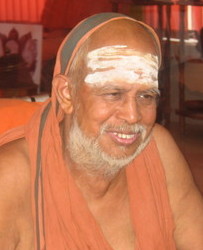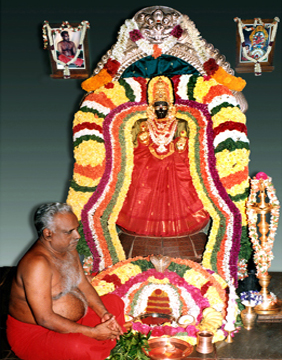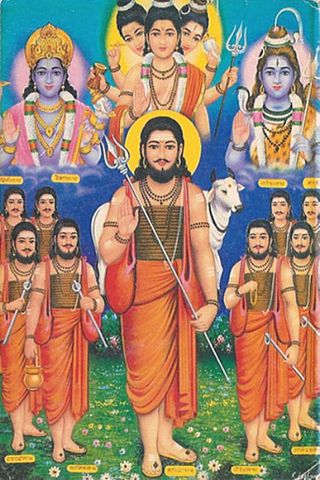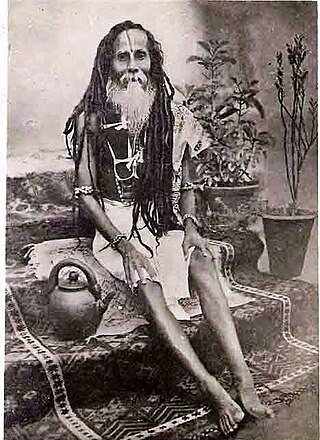
Sivananda Saraswati was a yoga guru, a Hindu spiritual teacher, and a proponent of Vedanta. Sivananda was born in Pattamadai, in the Tirunelveli district of Tamil Nadu, and was named Kuppuswami. He studied medicine and served in British Malaya as a physician for several years before taking up monasticism.

Sri Sarada Devi, born Kshemankari / Thakurmani / Saradamani Mukhopadhyay, was the wife and spiritual consort of Ramakrishna Paramahamsa, a nineteenth-century Hindu mystic. Sarada Devi is also reverentially addressed as the Holy Mother by the followers of the Sri Ramakrishna monastic order. The Sri Sarada Math and Ramakrishna Sarada Mission situated at Dakshineshwar is based on the ideals and life of Sarada Devi. She played an important role in the growth of the Ramakrishna Movement.

Jagadguru Sri Jayendra Saraswathi Shankaracharya was the 69th Shankaracharya Guru and head or pontiff (Pïțhādhipati) of the Kanchi Kamakoti Peetham. Subramanyam Mahadeva Iyer was nominated by his predecessor, Chandrashekarendra Saraswati, as his successor and was given the pontifical title Sri Jayendra Saraswathi on 22 March 1954.

Swami Brahmananda Saraswati, also known as Guru Dev, was the Shankaracharya of the Jyotir Math monastery in India. Born into a Saryupareen Brahmin family, he left home at the age of nine in search of a spiritual master. At age fourteen, he became a disciple of Svāmī Kṛṣṇānanda Sarasvatī. At the age of 34, he was initiated into the order of Sannyas and became the Śaṅkarācārya of Jyotir Math in 1941 at age 70, the first person to hold that office in 150 years. His disciples included Swami Shantanand Saraswati, Transcendental Meditation founder Maharishi Mahesh Yogi, Svāmī Swarūpānanda Sarasvatī and Swami Karpatri. According to the partisans of Shantānand Saraswati, Brahmānanda made a will five months before his death in 1953, naming Shantānand as his successor.

Tripura Sundari, also known as Rajarajeshvari, Shodashi, Kamakshi, and Lalita is a Hindu goddess, revered primarily within the Shaktism tradition and recognized as one of the ten Mahavidyas. She embodies the essence of the supreme goddess Mahadevi. Central to the Shakta texts, she is widely praised in the Lalita Sahasranama and Saundarya Lahari. In the Lalitopakhyana of the Brahmanda Purana, she is referred to as Adi Parashakti.

Jagadguru Shri Chandrasekharendra Saraswati Mahaswamigal also known as the Sage of Kanchi or Mahaperiyavar was the 68th Jagadguru Shankaracharya of the Kanchi Kamakoti Peetham. Mahaperiyavar's discourses have been recorded in a Tamil book titled "Deivathin Kural".
Shakatapuram, also known by the name Bhandigadi, is a religious place for Hindus located in the Koppa taluk of the state of Karnataka, India. It is located near Sringeri and is situated on the banks of river Tunga. It is famous for a Hindu Math called Shri Vidya Peetam which is present at this place. The Kumbhabhishekam event held at this place attracts a number of devotees.

Devipuram is a Hindu temple complex located near Visakhapatnam, Andhra Pradesh, India. Belonging primarily to the Shakta school of Hinduism, it is dedicated to the goddess Sahasrakshi, and her consort Kameshwara.

Guruji Shri Rishi Prabhakar (1948–2014) was an Indian yogi who instructed many spiritual teachers across the country. He was the founder of Rishi Samskruti Vidya Kendra, a Public Charitable Trust. He also developed many programs such as Siddha Samadhi Yoga (SSY), Kaya Kalpa Kriya (KKK), Advanced Meditation Course (AMC), Bhava Samadhi Training (BST), Hundred Percent Memory, Infant Siddha Program (ISP) and Inspirational Leadership in Rural Development (ILRD) for the well-being of humanity.
Guru Vandana means “Reverence for the Teacher” – it is the thanksgiving from a student to a teacher, expressing their gratitude. The Guru Vandana program provides a platform for students to honor their teachers for imparting knowledge and wisdom to them.
Sriramapura is a town in the southern state of Karnataka, India. It is located in the Hosadurga taluk of Chitradurga district in Karnataka.
H. H. Swami Santhananda Saraswati Avadhoota Swamigal born as Subrahmanyam was a Hindu spiritual leader and teacher who established the worship of Devi Bhuvaneswari in Tamil Nadu. He was the founder of the Bhuvaneswari Peetam in Pudukkottai, Tamil Nadu, India. The very embodiment of Prema, Sri Sri Swami Santhananda was the fountainhead of Hindu Dharma and Vedic principles. In his lifetime he had conducted several yagnas as elucidated in the Sasthras and challenged orthodoxy by bringing to light, guarded Moola Mantras that ensure common good, wealth and peace.

Sri Ramakrishna Math, Chennai is a monastic organisation for those men who were taught into existence by Sri Ramakrishna (1836–1886), a 19th-century saint of Bengal. The motto of the Ramakrishna Math and Ramakrishna Mission is: "For one's own salvation, and for the welfare of the world". The math in Chennai is the first branch center of the Ramakrishna Order in Southern India. It was established in 1897 by Swami Ramakrishnananda, one of the direct disciples of Sri Ramakrishna. Besides Swami Ramakrishnananda, the Math was visited by Holy Mother Sri Sarada Devi, Swami Nirmalananda, Swami Shivananda, Swami Abhedananda, Swami Premananda, Swami Niranjanananda, Swami Trigunatitananda, and Swami Vijnanananda.

Thuravoor is a gram panchayat in the Pattanakkad Block of Cherthala Taluk of the Alappuzha District, State of Kerala, India. It comes under Aroor Assembly constituency. Thuravoor lies exactly between Kochi and Alappuzha. A four lane National Highway 47 passes through the village, which along with a railway station gives it excellent connectivity with the remainder of the state. Thuravoor is famous for the Narasimha Swamy temple which is dedicated to the fourth incarnation (avatara) of Vishnu, the Narasimha. The temple has two main deities, the Vadakkanappan and the Tekkanappan, which is rare among the temples of Kerala.

Arulmigu Adhiparasakthi Siddhar Peetam is a Hindu temple in Melmaruvathur, approximately 92 km from Chennai in the southern state of Tamil Nadu, India. Tamil Nadu is the place where 21 Siddhars (saints) men as well as women from different religion, had their Jeeva-Samadhis. The divine mother Adhi Parashakti transmigrates into Arulthiru Bangaru Adigalar in Adiparashakti Siddhar Peetam.
Thycaud Ayyavu Swamikal was a spiritualist and a social reformer, the first to break customs related to caste in Kerala when caste restrictions and untouchability were at its extreme.

The Inchagiri Sampradaya, also known as Nimbargi Sampradaya, is a lineage of Hindu Navnath and Lingayat teachers from Maharashtra which was started by Bhausaheb Maharaj. It is inspired by Sant Mat teachers as Namdev, Raidas and Kabir. The Inchagiri Sampradaya has become well known throughout the western world due to the popularity of Nisargadatta Maharaj.

Sri Sri Sitaramdas Omkarnath was an Indian spiritual master. Addressed as Sri Sri Thakur Sitaramdas Omkarnath, where "Omkar" signifies the supreme cosmic enlightenment and attaining supreme consciousnes, he was heralded as the Divine Incarnate (Avatar) of Kali Yuga and espoused the doctrines of Sanatan Dharma and Vedic spiritual path to countless devotees from across the world, with central theme and paramount importance on the beneficence of Divine Chanting Naam of Hare Krishna Hare Ram - regarded as the omnipotent "Tarak Brahma Naam" the chant of soul deliverance in Kali Yuga and "Moksha" liberation from cycle of birth and death. As such, his disciples continue to worship him as an incarnation of the Lord himself and is verily regarded as an eternal source of spiritual enlightenment and soul succour to all seekers. because his life had been predicted in a manuscript of Achyutananda Dasa. Sitaramdas Omkarnath wrote more than 150 books to promote the essence of Indian scriptures, built more than 60 temples and ashrams all across India, and founded His spiritual organisation Akhil Bharat Jaiguru Sampradaya, established many groups, temples, mutts, both within and outside the Sampradaya— and was also the initiator of multiple magazines like Pather Alo, Devjan, JaiGuru, Arya Nari, Paramananda, and The Mother.

Vyasachala Mahadevendra Saraswati was the 54th Pontiff of the Kanchi Kamakoti Peetham from 1498 to 1507AD. He was the son of Kamesvara and Kamalamba who belonged to Kanchi. His pre-sanyasa name was Kuppanna and his guru was Purnananda Sadasivendra Saraswati. He is the author of Vyasachala Sankara Vijaya. He attained mukti at Vyasachala on the first day of the dark fortnight of Ashada in the cyclic year Akshaya. The Acharyal has been described as great tapasvi and besmeared with holy vibhuthi and engaged himself in Shiva aradhana. The jeeva samadhi of Vyasachala Mahadevendra Saraswati is located in Sri Nallinaikeshwarar temple Ezhichur which is 55 km from Chennai. The Shiva Linga was worshipped by Surya and Chandra Bhagavan. There is a temple pond which was created by Surya Bhagavan for worshipping Lord Nallinakeshwarar. It's said that 7 Siddhas pray to the Shiva Linga in the form of snakes and one who is steeped in devotion can have the good fortune of having darshan of them. Acharyal Vyasachala Mahadevendra Saraswati attained videha mukti and went into Agni Mudra through which he was immediately transformed to sacred vibhuthi. It's said that one should chant Pancaksara Mantra with devotion to have darshan of the acharya in person or through speech or visions. The sacred vibhuthi provided by the priest should be only used during the evening and one should take care not to commit any aparadha or any sin. After his mukti, the disciplic succession was carried over by Chandrachudhendra Saraswati II,
The Parashurama Kalpasutra is a Shakta Agama, a Hindu text on Shri Vidya practices ascribed to the Kaula tradition. The authorship of the text is traditionally attributed to Parashurama, the sixth avatar of Vishnu and a disciple of Dattatreya. It is a sacred text for the Shri Vidya worshippers of the goddess Lalita, who is considered to be a manifestation of the goddess Adi Parashakti. The text is also used in the worship of Ganesha, Bala Tripurasundari, Matangi, and Varahi. This text has its origins in the Dattatreya Samhita and was compiled by Sumedha, a disciple of Dattatreya.




































